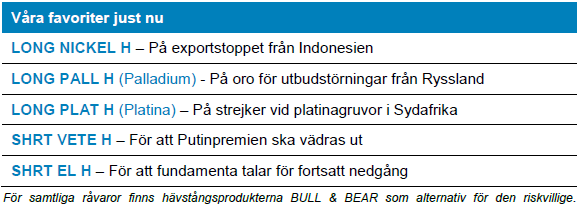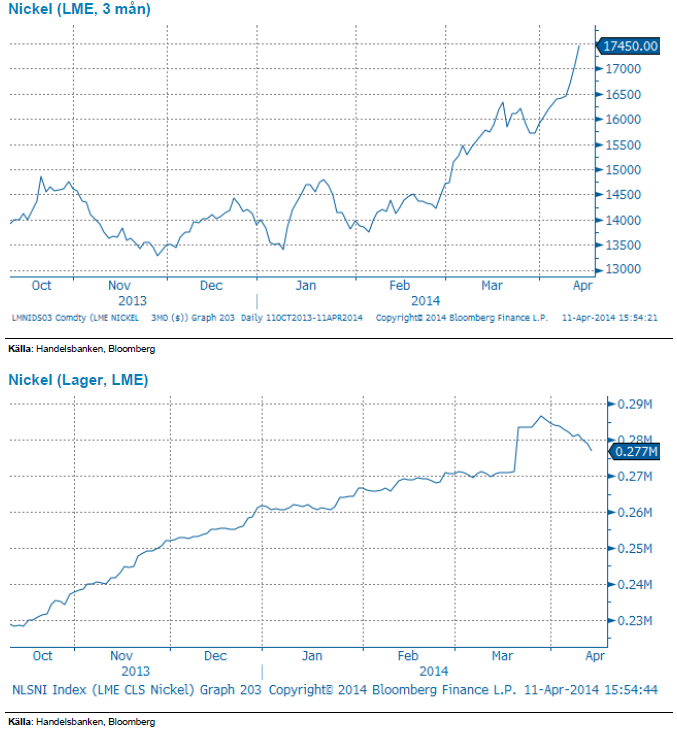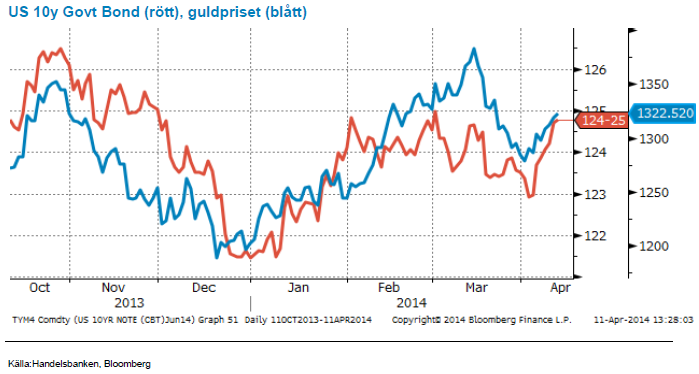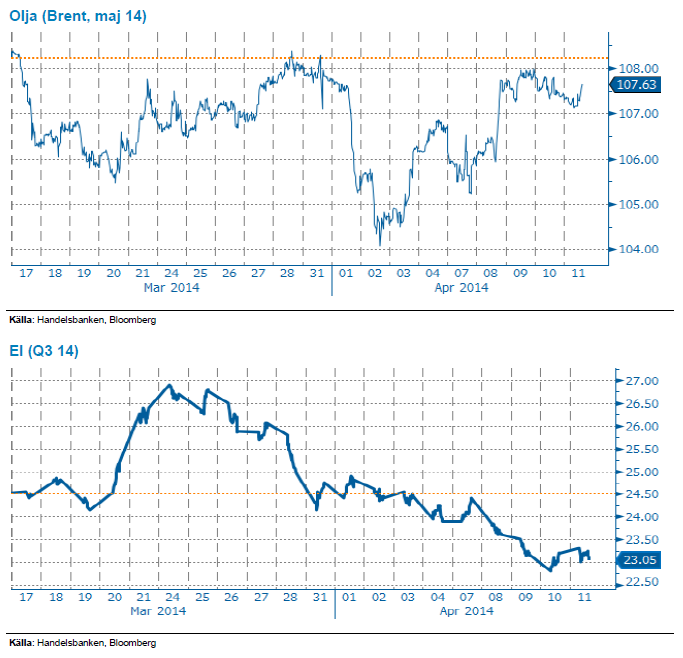Analys
SHB Råvarubrevet 11 april 2014

 Råvaror allmänt: Upp till bevis!
Råvaror allmänt: Upp till bevis!
Efter flera månader av oväntat svag amerikansk statistik som har skyllts på vädret är till slut det amerikanska makroöverraskningsindexet på nivåer där det ofta vänt högre. Väderleken får dessutom anses vara normal. Att marknaden tidigare inte tagit till sig den utbredda makrosvagheten förklaras med att en rejäl aktivitetstuds är att vänta när väl vädret normaliseras, men hur mycket uppdämd efterfrågan ligger i korten egentligen?
USA-statistiken har fortsatt att överraska negativt, trots den mer gynnsamma väderleken. Inköpschefsindex ISM var något sämre än väntat. Sysselsättningsstatistiken för mars månad var även den sämre än väntat. Speciellt relevant var lönetillväxten som bromsade in. Bilförsäljningen var förvisso stark och andas att lagerneddragningen i industrin inte behöver bli lika allvarlig, men någon större ketchupeffekt i efterfrågan går det inte ännu att tala om.
Med överraskningsindex på dessa nedtryckta nivåer (bild nedan) borde ekonomernas förväntningar vara så nedtryckta att data svårligen kan överraska negativt. Den utbredda förekomsten av väderursäkter under det första kvartalet kan dock utgöra ett tecken på att förväntansbilden inte är tillräckligt lågt ställd riktigt ännu. Medan nivån på överraskningsindex antyder att en förbättring är på gång noterar vi att mönstret under åren 2010 till 2013 andas att överraskningsindex brukar bottna ut först under sommaren.
Under veckan kom Kinas importdata för råvaror under mars månad. Relativt oförändrad från februari och klart lägre än rekordimporten i slutet av 2013 och jan 2014. Importen ligger i linje med vårt case där Kina just nu befinner sig i en tillverkningsintensiv period då råvaror tas från lagerhus och omsätts till färdiga bilar, tvättmaskiner och allt annat som ingår i industriproduktionen.
Basmetaller: Favoritmetallen fortsätter att leverera
Sedan vi publicerade vårt nickel case den 1 april har priset (LME:s 3 mån) stigit med dryga 10 %, upp hittills i år med hela 25 %. Indonesiens exportstopp av oförädlad nickelmalm börjar nu påverka utbudet, men även oro för bortfall från Ryssland oroar. Kinas lager av malmen börjar sina och även LME:s lager av nickel faller, ned 1,8 % på veckan vilket är den största nedgången sedan juni 2012. Det har dock ryktats att man i Indonesien skulle lätta på sitt exportförbud, i syfte att stimulera sysselsättningen inför stundande val. De aktörer vi talar med i den fysiska nickelmarknaden vittnar samtidigt om att det blir allt svårare att köpa nickel för leverans. Vi håller därför fast vid vår positiva syn på nickel även efter från dessa prisnivåer.
Ädelmetaller: Guldet fortfarande Fed-styrt
Som vi beskrev i förra veckans brev sitter nya Fed-chefen Janet Yellen på nyckeln till prisutvecklingen på guldet. Beskedet i början av mars tolkades som oväntat hökaktigt, vilket ledde till stigande amerikanska räntor och fallande ädelmetallpriser.
Sedan dess har budskapet ”mjukats till” en hel del, en utveckling som förstärktes i denna veckans publicerade mötesprotokoll från Fed. Amerikanska räntor har fallit en hel del, och guldpriset har börjat stiga igen. Sedan förra veckan noterar vi prisuppgångar på ädelmetallerna och guldet har nu drygt fyra procent kvar till årshögstanoteringen. Vi bibehåller vår positiva syn men håller stort fokus på Fed och ränteutvecklingen. Nästa Fed-möte är 29-30 april.
Energi: Elpriset fortsätter sin väg ned
Elmarknaden och elkontraktet Q3 2014 faller ytterligare 3 procent under veckan till EUR 23.05 och vi står fast vid vår negativa vy. Även om utsläppsrätterna, gas- och kolkontrakten stigit något går det inte att bortse från de extremt våta vädret som ger förutsättningar för ytterligare nedgång på kontraktet. Ser vi till den kommande tiodagarsperioden kan det bli riktigt stora energileveranser uppemot 10 TWh vilket i så fall skulle stärka energibalansen till närmare 1.5 TWh + efter vecka 16. Det är väl egentligen bara gasen som stigit på oro kring utvecklingen i Ukraina/Ryssland och därmed också givit stöd åt det tyska elpriset som kan lyftas fram som en liten orosparameter men just nu balanseras detta klart av vädret.
Oljan fortsätter att vara rangehandlad. Libyens rebeller börjar öppna upp för export från de två sista av de hamnar som de kontrollerar vilket pressar priset men Putins hotfulla tonläge leder till högre pris. Det är alltså riskpremien som handlas upp och ner men underliggande fundamenta har förbättrats i och med bättre utsikter för Libyen att komma tillbaka till export.
Livsmedel: Kaffepriset vänder upp igen
Terminspriserna på kaffe är tillbaka på årshögsta och handlas åter över 2 dollar/Ib. Priserna föll tillbaka efter vinsthemtagningar och viss nederbörd i Brasilien under mars månad. Veckans prislyft speglar återigen bristen på regn för de kommande veckorna men också minskade Robustalager. Dessutom hotar El Niño kommande skörd, där stora mängder nederbörd kan försämra kvalitén på bönorna. Vi tror fortsatt på en volatil marknad.
Efter den ovanligt kalla vintern i USA och uteblivet regn i Brasilien, väntas årets apelsinskörd bli den lägsta på 29 år. Brasilien som världens största – och Florida som världens näst största apelsinproducent har drabbats hårt i år. I veckan steg terminspriserna på apelsinjuice ytterligare till två-årshögsta efter att amerikanska jordbruksdepartementet, USDA sänkte den amerikanska apelsinodlingens estimat för mars månad för 2013/14 jämfört med föregående månad. I Florida härjar den bakteriella citrussjukdomen även kallad Citrus greening som får apelsinerna att skrumpna och lossna innan de hunnit mogna. Och i Brasilien har torkan slagit hårt mot apelsinerna. Om Citrus greening får spridning kan det påverka flera års skördar, varför vi ser viss risk på uppsidan.
Vete avslutar veckan i princip oförändrat efter en kortare uppgång under veckan. I onsdagens rapport från det amerikanska jordbruksdepartementet, USDA, justerades globalt utgående lager av vete upp mer än väntat med 3 miljoner ton – vilket pressat priserna en del därefter. Generellt sett är de höstsådda grödorna i ett gott skick på det norra halvklotet, det största problemet har varit torkan för det amerikanska höstvetet – vilket dock fortfarande oroar men i alla fall lindrats. För tillfället ser det även ut som att mer regn kommer i nästa vecka. Marknaden kommer nu mest fokusera på väder och utsikter för ny skörd – vilket än så länge ser lovande ut. Vi fortsätter att tro på fallande vetepriser.
Handelsbankens råvaruindex (USD)
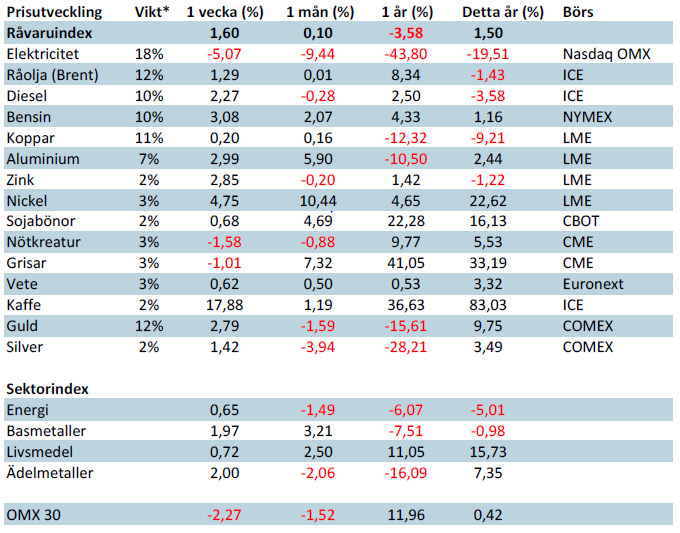
*Uppdaterade vikter från 29 november 2013
Handelsbankens råvaruindex består av de underliggande indexen för respektive råvara. Vikterna är bestämda till hälften från värdet av nordisk produktion (globala produktionen för sektorindex) och till hälften från likviditeten i terminskontrakten.
[box]SHB Råvarubrevet är producerat av Handelsbanken och publiceras i samarbete och med tillstånd på Råvarumarknaden.se[/box]
Ansvarsbegränsning
Detta material är producerat av Svenska Handelsbanken AB (publ) i fortsättningen kallad Handelsbanken. De som arbetar med innehållet är inte analytiker och materialet är inte oberoende investeringsanalys. Innehållet är uteslutande avsett för kunder i Sverige. Syftet är att ge en allmän information till Handelsbankens kunder och utgör inte ett personligt investeringsråd eller en personlig rekommendation. Informationen ska inte ensamt utgöra underlag för investeringsbeslut. Kunder bör inhämta råd från sina rådgivare och basera sina investeringsbeslut utifrån egen erfarenhet.
Informationen i materialet kan ändras och också avvika från de åsikter som uttrycks i oberoende investeringsanalyser från Handelsbanken. Informationen grundar sig på allmänt tillgänglig information och är hämtad från källor som bedöms som tillförlitliga, men riktigheten kan inte garanteras och informationen kan vara ofullständig eller nedkortad. Ingen del av förslaget får reproduceras eller distribueras till någon annan person utan att Handelsbanken dessförinnan lämnat sitt skriftliga medgivande. Handelsbanken ansvarar inte för att materialet används på ett sätt som strider mot förbudet mot vidarebefordran eller offentliggörs i strid med bankens regler.
Analys
Tightening fundamentals – bullish inventories from DOE

The latest weekly report from the US DOE showed a substantial drawdown across key petroleum categories, adding more upside potential to the fundamental picture.

Commercial crude inventories (excl. SPR) fell by 5.8 million barrels, bringing total inventories down to 415.1 million barrels. Now sitting 11% below the five-year seasonal norm and placed in the lowest 2015-2022 range (see picture below).
Product inventories also tightened further last week. Gasoline inventories declined by 2.1 million barrels, with reductions seen in both finished gasoline and blending components. Current gasoline levels are about 3% below the five-year average for this time of year.
Among products, the most notable move came in diesel, where inventories dropped by almost 4.1 million barrels, deepening the deficit to around 20% below seasonal norms – continuing to underscore the persistent supply tightness in diesel markets.
The only area of inventory growth was in propane/propylene, which posted a significant 5.1-million-barrel build and now stands 9% above the five-year average.
Total commercial petroleum inventories (crude plus refined products) declined by 4.2 million barrels on the week, reinforcing the overall tightening of US crude and products.


Analys
Bombs to ”ceasefire” in hours – Brent below $70

A classic case of “buy the rumor, sell the news” played out in oil markets, as Brent crude has dropped sharply – down nearly USD 10 per barrel since yesterday evening – following Iran’s retaliatory strike on a U.S. air base in Qatar. The immediate reaction was: “That was it?” The strike followed a carefully calibrated, non-escalatory playbook, avoiding direct threats to energy infrastructure or disruption of shipping through the Strait of Hormuz – thus calming worst-case fears.

After Monday morning’s sharp spike to USD 81.4 per barrel, triggered by the U.S. bombing of Iranian nuclear facilities, oil prices drifted sideways in anticipation of a potential Iranian response. That response came with advance warning and caused limited physical damage. Early this morning, both the U.S. President and Iranian state media announced a ceasefire, effectively placing a lid on the immediate conflict risk – at least for now.
As a result, Brent crude has now fallen by a total of USD 12 from Monday’s peak, currently trading around USD 69 per barrel.
Looking beyond geopolitics, the market will now shift its focus to the upcoming OPEC+ meeting in early July. Saudi Arabia’s decision to increase output earlier this year – despite falling prices – has drawn renewed attention considering recent developments. Some suggest this was a response to U.S. pressure to offset potential Iranian supply losses.
However, consensus is that the move was driven more by internal OPEC+ dynamics. After years of curbing production to support prices, Riyadh had grown frustrated with quota-busting by several members (notably Kazakhstan). With Saudi Arabia cutting up to 2 million barrels per day – roughly 2% of global supply – returns were diminishing, and the risk of losing market share was rising. The production increase is widely seen as an effort to reassert leadership and restore discipline within the group.
That said, the FT recently stated that, the Saudis remain wary of past missteps. In 2018, Riyadh ramped up output at Trump’s request ahead of Iran sanctions, only to see prices collapse when the U.S. granted broad waivers – triggering oversupply. Officials have reportedly made it clear they don’t intend to repeat that mistake.
The recent visit by President Trump to Saudi Arabia, which included agreements on AI, defense, and nuclear cooperation, suggests a broader strategic alignment. This has fueled speculation about a quiet “pump-for-politics” deal behind recent production moves.
Looking ahead, oil prices have now retraced the entire rally sparked by the June 13 Israel–Iran escalation. This retreat provides more political and policy space for both the U.S. and Saudi Arabia. Specifically, it makes it easier for Riyadh to scale back its three recent production hikes of 411,000 barrels each, potentially returning to more moderate increases of 137,000 barrels for August and September.
In short: with no major loss of Iranian supply to the market, OPEC+ – led by Saudi Arabia – no longer needs to compensate for a disruption that hasn’t materialized, especially not to please the U.S. at the cost of its own market strategy. As the Saudis themselves have signaled, they are unlikely to repeat previous mistakes.
Conclusion: With Brent now in the high USD 60s, buying oil looks fundamentally justified. The geopolitical premium has deflated, but tensions between Israel and Iran remain unresolved – and the risk of missteps and renewed escalation still lingers. In fact, even this morning, reports have emerged of renewed missile fire despite the declared “truce.” The path forward may be calmer – but it is far from stable.
Analys
A muted price reaction. Market looks relaxed, but it is still on edge waiting for what Iran will do

Brent crossed the 80-line this morning but quickly fell back assigning limited probability for Iran choosing to close the Strait of Hormuz. Brent traded in a range of USD 70.56 – 79.04/b last week as the market fluctuated between ”Iran wants a deal” and ”US is about to attack Iran”. At the end of the week though, Donald Trump managed to convince markets (and probably also Iran) that he would make a decision within two weeks. I.e. no imminent attack. Previously when when he has talked about ”making a decision within two weeks” he has often ended up doing nothing in the end. The oil market relaxed as a result and the week ended at USD 77.01/b which is just USD 6/b above the year to date average of USD 71/b.

Brent jumped to USD 81.4/b this morning, the highest since mid-January, but then quickly fell back to a current price of USD 78.2/b which is only up 1.5% versus the close on Friday. As such the market is pricing a fairly low probability that Iran will actually close the Strait of Hormuz. Probably because it will hurt Iranian oil exports as well as the global oil market.
It was however all smoke and mirrors. Deception. The US attacked Iran on Saturday. The attack involved 125 warplanes, submarines and surface warships and 14 bunker buster bombs were dropped on Iranian nuclear sites including Fordow, Natanz and Isfahan. In response the Iranian Parliament voted in support of closing the Strait of Hormuz where some 17 mb of crude and products is transported to the global market every day plus significant volumes of LNG. This is however merely an advise to the Supreme leader Ayatollah Ali Khamenei and the Supreme National Security Council which sits with the final and actual decision.
No supply of oil is lost yet. It is about the risk of Iran closing the Strait of Hormuz or not. So far not a single drop of oil supply has been lost to the global market. The price at the moment is all about the assessed risk of loss of supply. Will Iran choose to choke of the Strait of Hormuz or not? That is the big question. It would be painful for US consumers, for Donald Trump’s voter base, for the global economy but also for Iran and its population which relies on oil exports and income from selling oil out of that Strait as well. As such it is not a no-brainer choice for Iran to close the Strait for oil exports. And looking at the il price this morning it is clear that the oil market doesn’t assign a very high probability of it happening. It is however probably well within the capability of Iran to close the Strait off with rockets, mines, air-drones and possibly sea-drones. Just look at how Ukraine has been able to control and damage the Russian Black Sea fleet.
What to do about the highly enriched uranium which has gone missing? While the US and Israel can celebrate their destruction of Iranian nuclear facilities they are also scratching their heads over what to do with the lost Iranian nuclear material. Iran had 408 kg of highly enriched uranium (IAEA). Almost weapons grade. Enough for some 10 nuclear warheads. It seems to have been transported out of Fordow before the attack this weekend.
The market is still on edge. USD 80-something/b seems sensible while we wait. The oil market reaction to this weekend’s events is very muted so far. The market is still on edge awaiting what Iran will do. Because Iran will do something. But what and when? An oil price of 80-something seems like a sensible level until something do happen.
-

 Nyheter4 veckor sedan
Nyheter4 veckor sedanStor uppsida i Lappland Guldprospekterings aktie enligt analys
-

 Nyheter4 veckor sedan
Nyheter4 veckor sedanSilverpriset släpar efter guldets utveckling, har mer uppsida
-

 Nyheter3 veckor sedan
Nyheter3 veckor sedanUppgången i oljepriset planade ut under helgen
-

 Nyheter2 veckor sedan
Nyheter2 veckor sedanMahvie Minerals växlar spår – satsar fullt ut på guld
-

 Nyheter3 veckor sedan
Nyheter3 veckor sedanLåga elpriser i sommar – men mellersta Sverige får en ökning
-

 Analys3 veckor sedan
Analys3 veckor sedanVery relaxed at USD 75/b. Risk barometer will likely fluctuate to higher levels with Brent into the 80ies or higher coming 2-3 weeks
-

 Nyheter2 veckor sedan
Nyheter2 veckor sedanOljan, guldet och marknadens oroande tystnad
-

 Nyheter2 veckor sedan
Nyheter2 veckor sedanJonas Lindvall är tillbaka med ett nytt oljebolag, Perthro, som ska börsnoteras


